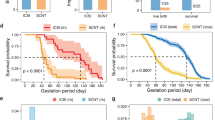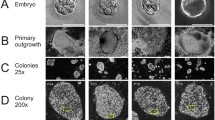Abstract
Objective
To investigate the effect of the small molecule, RepSox, on the expression of developmentally important genes and the pre-implantation development of rhesus monkey–pig interspecies somatic cell nuclear transfer (iSCNT) embryos.
Results
Rhesus monkey cells expressing the monomeric red fluorescent protein 1 which have a normal (42) chromosome complement, were used as donor cells to generate iSCNT embryos. RepSox increased the expression levels of the pluripotency-related genes, Oct4 and Nanog (p < 0.05), but not of Sox2 compared with untreated embryos at the 2–4-cell stage. Expression of the anti-apoptotic gene, Bcl2, and the pro-apoptotic gene Bax was also affected at the 2–4-cell stage. RepSox treatment also increased the immunostaining intensity of Oct4 at the blastocyst stage (p < 0.05). Although the blastocyst developmental rate was higher in the group treated with 25 µM RepSox for 24 h than in the untreated control group (2.4 vs. 1.2%, p > 0.05), this was not significant.
Conclusion
RepSox can improve the developmental potential of rhesus monkey–pig iSCNT embryos by regulating the expression of pluripotency-related genes.




Similar content being viewed by others
References
Coy P, Gadea J, Romar R et al (2002) Effect of in vitro fertilization medium on the acrosome reaction, cortical reaction, zona pellucida hardening and in vitro development in pigs. Reproduction 124:279–288
Hou PP, Li YQ, Zhang X et al (2013) Pluripotent stem cells induced from mouse somatic cells by small-molecule compounds. Science 341:651–654
Huang JJ, Zhang HY, Yao J et al (2009) BIX-01294 increases pig cloning efficiency by improving epigenetic reprogramming of somatic cell nuclei. Reproduction 151:39–49
Ichida JK, Blanchard J, Lam K et al (2009) A small-molecule inhibitor of tgf-Beta signaling replaces sox2 in reprogramming by inducing nanog. Cell Stem Cell 5:491–503
Jiang Y, Kelly R, Peters A et al (2011) Interspecies somatic cell nuclear transfer is dependent on compatible mitochondrial DNA and reprogramming factors. PLoS ONE 6:e14805
Kang JD, Li S, Lu Y et al (2013) Valproic acid improved in vitro development of pig cloning embryos but did not improve survival of cloned pigs to adulthood. Theriogenology 79:306–311
Latham KE (2005) Early and delayed aspects of nuclear reprogramming during cloning. Biol Cell 97:119–132
Okita K, Ichisaka T, Yamanaka S (2007) Generation of germline-competent induced pluripotent stem cells. Nature 448:313–317
Rideout WM III, Eggan K, Jaenisch R (2001) Nuclear cloning and epigenetic reprogramming of the genome. Science 293:1093–1098
Shi W, Zakhartchenko V, Wolf E (2003) Epigenetic reprogramming in mammalian nuclear transfer. Differentiation 71:91–113
Shi LH, Miao YL, Ouyang YC et al (2008) Trichostatin A (trichostatin A) improves the development of rabbit–rabbit intraspecies cloned embryos, but not rabbit–human interspecies cloned embryos. Dev Dyn 237:640–648
Srirattana K, Laowtammathron C, Devahudi R et al (2008) Effect of trichostatin A on developmental potential of interspecies cloned gaur (Bos gaurus) embryos. Reprod Fertil Dev 21:126–127
Sugimura S, Narita K, Yamashiro H et al (2009) Interspecies somatic cell nucleus transfer with porcine oocytes as recipients: a novel bioassay system for assessing the competence of canine somatic cells to develop into embryos. Theriogenology 72:549–559
Tachibana M, Sparman M, Ramsey C et al (2012) Generation of chimeric rhesus monkeys. Cell 148:285–295
Tsuji Y, Kato Y, Tsunoda Y (2009) The developmental potential of mouse somatic cell nuclear-transferred oocytes treated with trichostatin A and 5-aza-2′-deoxycytidine. Zygote 2:109–115
**ong XR, Lan DL, Li J et al (2015) Sodium butyrate improves the cloned yak embryo viability and corrects gene expression patterns. Zygote 23:19–26
Yamanaka K, Sugimura S, Wakai T et al (2009) Acetylation level of histone H3 in early embryonic stages affects subsequent development of miniature pig somatic cell nuclear transfer embryos. J Reprod Dev 55:638–644
Yin XJ, Tani T, Yonemura I et al (2002) Production of cloned pigs from adult somatic cells by chemically assisted removal of maternal chromosomes. Biol Reprod 67:442–446
Zhang H, Wang Y, Sang Y et al (2014) Combination of S-adenosylhomocysteine and scriptaid, a non-toxic epigenetic modifying reagent, modulates the reprogramming of bovine somatic-cell nuclear transfer embryos. Mol Reprod Dev 81:87–97
Zhu HY, Kang JD, Li S et al (2014) Production of rhesus monkey cloned embryos expressing monomeric red fluorescent protein by interspecies somatic cell nuclear transfer. Biochem Biophys Res Commun 444:638–643
Zuo Y, Gao Y, Su G et al (2014) Irregular transcriptome reprogramming probably causes thec developmental failure of embryos produced by interspecies somatic cell nuclear transfer between the Przewalski’s gazelle and the bovine. BMC Genomics 15:1113
Acknowledgements
We thank **aohui Wu at Fudan University for providing the pCX-mRFP1 vector. This work was supported by the Science and Technology Development Projects of Jilin Province of China (Grant No. 20160520057JH) and the 13th Five-Year Plan Science and Technology Research Project of Education Department of Jilin Province of China (Grant No. [2016]-257).
Supporting information
Supplementary Table 1—List of primers.
Author information
Authors and Affiliations
Corresponding author
Additional information
Hai-Ying Zhu and Long ** have contributed equally to this study.
Electronic supplementary material
Below is the link to the electronic supplementary material.
Rights and permissions
About this article
Cite this article
Zhu, HY., **, L., Guo, Q. et al. RepSox improves viability and regulates gene expression in rhesus monkey–pig interspecies cloned embryos. Biotechnol Lett 39, 775–783 (2017). https://doi.org/10.1007/s10529-017-2308-3
Received:
Accepted:
Published:
Issue Date:
DOI: https://doi.org/10.1007/s10529-017-2308-3




